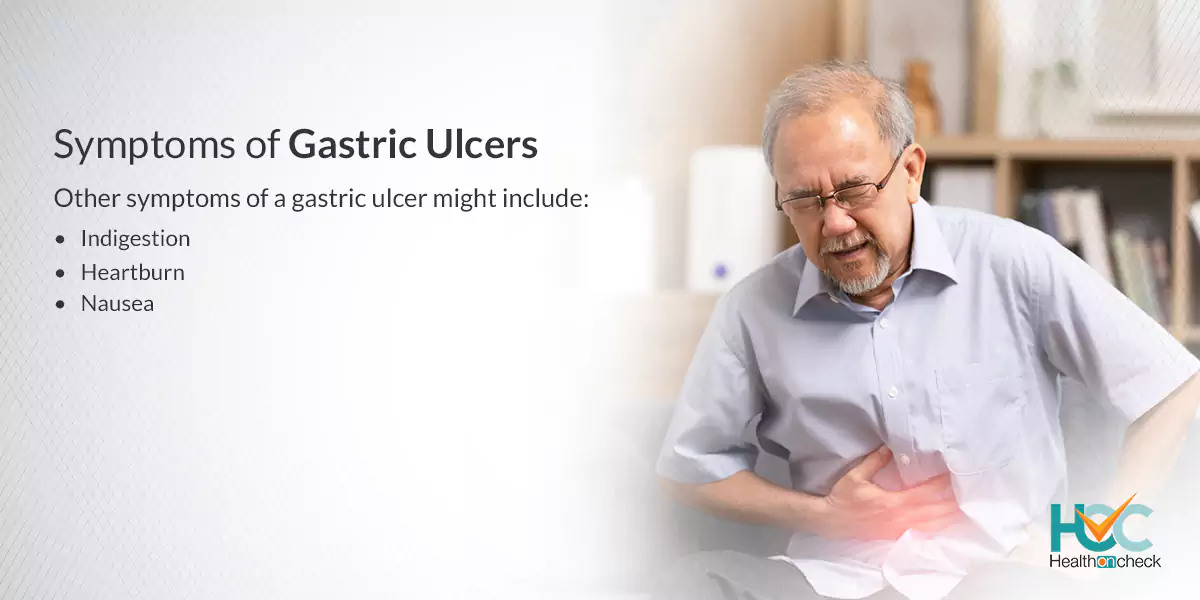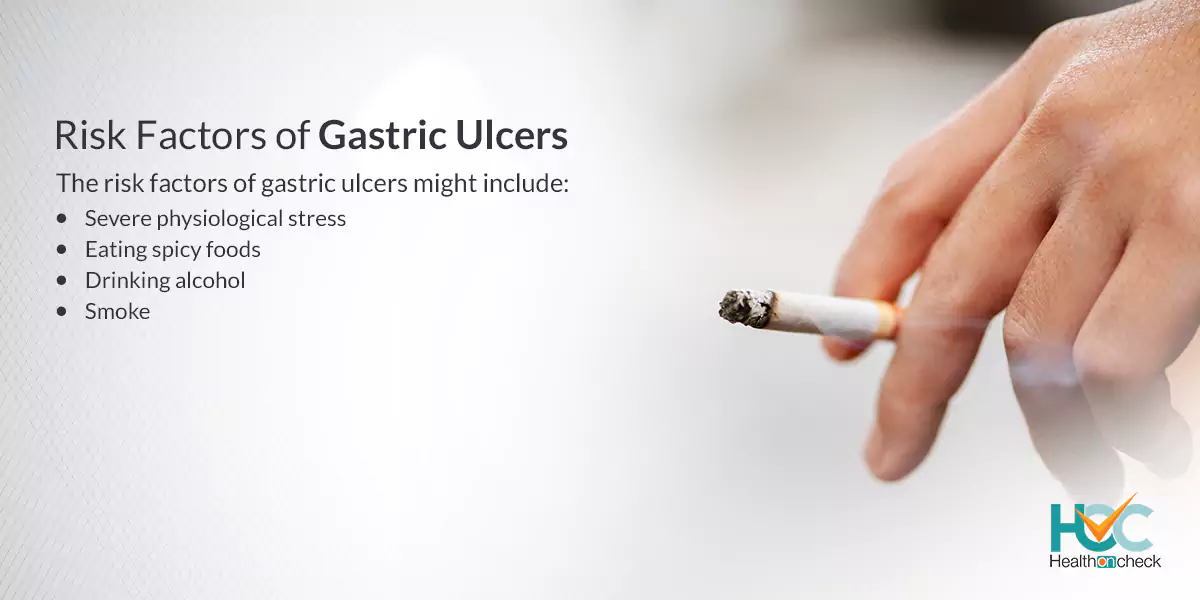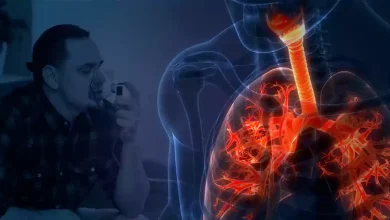What are Gastric Ulcers?

Gastric ulcers, also called stomach ulcers, are open sores that develop on the lining of the stomach. They are a break in the mucosal barrier of the stomach lining penetrating through the muscularis mucosa and are above 5 mm in diameter in size. Ulcers can also develop in portions of the intestine just below the stomach. These are known as duodenal ulcers. Stomach and duodenal ulcers are sometimes called peptic ulcers. Pepsin, a digestive juice found in the stomach that sometimes leaks into the duodenum is a contributing factor in peptic ulcer disease. Duodenal ulcers and gastric ulcers both are forms of peptic ulcers. Gastric ulcers develop on the inside of the stomach and if left untreated, a gastric ulcer can cause severe complications, including internal bleeding and with passing time they can even wear a hole all the way through, which often requires a medical emergency.
What are the Types of Gastric Ulcers?
The types of gastric ulcers include:
– Type 1
It develops in the antrum, adjacent to the lesser curvature.
– Type 2
It’s a combination of gastric and duodenal ulcer.
– Type 3
Also known as prepyloric ulcer, here the open sores occur in the upper digestive tract, above the pylorus, the opening to the small intestine
– Type 4
In this type, the ulcers develop in the proximal stomach or cardia.
What are the Symptoms of Gastric Ulcers?
The most common symptom of a gastric ulcer is a burning or niggling pain in the centre of the abdomen but all gastric ulcers are not painful.
Other symptoms of a gastric ulcer might include:
– Indigestion
– Heartburn
– Nausea
What are the Causes of Gastric Ulcers?
Gastric ulcers might occur because of:
– H. pylori infection
It’s a common bacterial infection that affects nearly half of people across the globe. This infection mainly occurs in the stomach and it doesn’t seem to cause problems in many people because their gut immune systems keep it in control. But some people with this infection have H. pylori overgrowth where the bacteria keeps on multiplying and starts eating into the stomach lining resulting in chronic inflammation and peptic ulcer disease. H. pylori infection is linked with nearly 60% of duodenal ulcers and 40% of gastric ulcers.
– NSAID overuse
NSAID is the acronym for “non-steroidal anti-inflammatory drug” which includes common over-the-counter pain relief medications including naproxen, ibuprofen, and aspirin. NSAIDs contribute to ulcers in many ways and mainly they irritate the stomach lining on contact and repress a few of the chemicals defending and repairing the mucous lining. Around 30% of people who take NSAIDs regularly develop peptic ulcers and nearly half of all peptic ulcers are caused by the overuse of NSAIDs. Gastric ulcer is a type of peptic ulcer.
– Zollinger-Ellison Syndrome
It is a rare condition that leads to your stomach producing too much gastric acid.
What are the Risk Factors for Gastric Ulcers?
The risk factors of gastric ulcers might include:
– Severe physiological stress
Serious illness, injuries, or burns can create stress ulcers in the stomach. Your body’s PH balance can be changed because of physiological stress and increased stomach acid. Stress ulcers develop quite rapidly in response to stress, unlike normal stomach ulcers that gradually develop.
– Smoke
Smoking may increase the risk of gastric ulcers among people infected with H. pylori.
– Drinking alcohol
Alcohol can erode and irritate the mucous lining of your stomach, thus increasing the levels of stomach acid produced.
– Eating spicy foods
Eating spicy food alone can’t cause gastric ulcers but it can worsen the ulcers and make them difficult to heal.
What are the Complications of Gastric Ulcers?
If not treated, gastric ulcers can lead to several complications including:
– Internal bleeding
– A hole in your stomach wall
– Blockage in the digestive tract
– Gastric cancer
How Gastric Ulcers are Diagnosed?
Your doctor will first ask you about your symptoms and medical history. After that, they will ask whether you have regularly used NSAIDs or have a history of H. pylori infection. If signs indicate an ulcer, they examine inside your stomach and duodenum.
Tests to diagnose a gastric ulcer include:
– Endoscopy
An upper endoscopy exam is helpful in diagnosing ulcers because it permits your doctor to see inside your digestive tract and also take a tissue sample for analysis in the lab. This test is carried out by passing a thin tube with a small camera placed down your throat and into your duodenum and stomach. You will be given medication to numb your throat and help you relax while the test is done. Your doctor might take a tissue sample using an endoscope to test for signs of other conditions that might cause stomach ulcers such as mucous damage, H. pylori infection, anaemia, or malignancy.
– Imaging tests
Imaging tests done to look inside the stomach and small intestine include:
Upper GI series
An upper GI X-ray exam checks the stomach and duodenum by using X-rays. It’s not as invasive as an endoscopy. You will be made to swallow chalky fluid called barium, which will coat your oesophagus, duodenum, and stomach for the X-ray. The barium helps show your digestive organs better in black-and-white images.
CT scan
You may prescribe a CT scan if it’s important to see your organs in quite detail. A CT scan is helpful to show complications including a perforation in the intestine wall or stomach. To carry out the test, you will be made to lay on a table inside a scanner machine and then X-rays will be taken. You might have to drink or have an injection containing contrast fluid which helps to show your organs better in images.
Tests for H. pylori
Your doctor may test you separately for H. pylori infection. Tests might include:
– Blood test
A sample of your blood will be taken and sent to a lab to look for evidence of antibodies to the bacteria in your blood which causes H.pylori infection. Though it’s not as accurate for diagnosing an active infection.
– Stool test
H. pylori can be diagnosed by testing samples of your poop.
– Breath test
The H. pylori breath test is considered to be the most accurate test to diagnose an active H. pylori infection. For the test, you will be made to drink a flavoured solution that contains an organic chemical compound called urea. In case H. pylori bacteria are there in your digestive tract, the urea will be broken down and converted into carbon dioxide. The carbon dioxide will come out in your breath. When you breathe into a bag, your doctor will measure it.
What are the Treatment Options Available for Gastric Ulcers?
Ulcers can be healed provided they are given a rest from the factors that caused them. Uncomplicated ulcers can be treated with a combination of medicines to decrease stomach acid, coat and protect the ulcer while getting healed, and remove any bacterial infection that might be involved. Medicines to cure gastric ulcers may include:
– Antibiotics
If in your digestive tract, H. pylori has been found, then your doctor might prescribe some combination of antibiotics to kill the bacteria, depending on your medical history
– Proton pump inhibitors (PPIs)
These medicines help decrease stomach acid and protect your stomach lining. PPIs include dexlansoprazole, esomeprazole, lansoprazole, pantoprazole, omeprazole and rabeprazole.
– Histamine receptor blockers (H2 blockers)
These decrease stomach acid as they block the chemical that commands your body to produce it. H2 blockers include cimetidine, famotidine, and nizatidine.
– Antacids
These are the common over-the-counter medicines that are helpful to neutralise stomach acid. They might get you some relief from the symptoms of ulcers but aren’t enough to cure them. They might also interfere with a few antibiotics.
– Cytoprotective agents
These medicines are helpful to protect and coat your stomach lining. They include misoprostol and sucralfate.
– Bismuth Subsalicylate
It’s an over-the-counter medicine, commonly found as Pepto-Bismol. It can help protect and coat your ulcer from stomach acid.
Living with Gastric Ulcers
Gastric ulcers are common and treatable, but they should not be taken lightly. Even when they are not causing any symptoms, they aren’t a good sign. A gastric ulcer implies that your natural stomach acid is overwhelming your protective stomach lining and this situation can worsen if it is not treated timely. Lifestyle changes might help to control and manage the symptoms, but you’ll still be required to treat the underlying factor. Either a common bacterial infection or NSAID use might be causing the ulcers. Your doctor can help prescribe the right medicines to treat your condition.
Whom to Consult?
You should consult with your doctor if you experience the symptoms of gastric ulcer, especially indigestion and pain in the abdomen. You should also seek medical attention if over-the-counter antacids and acid blockers relieve your pain but the pain returns.






